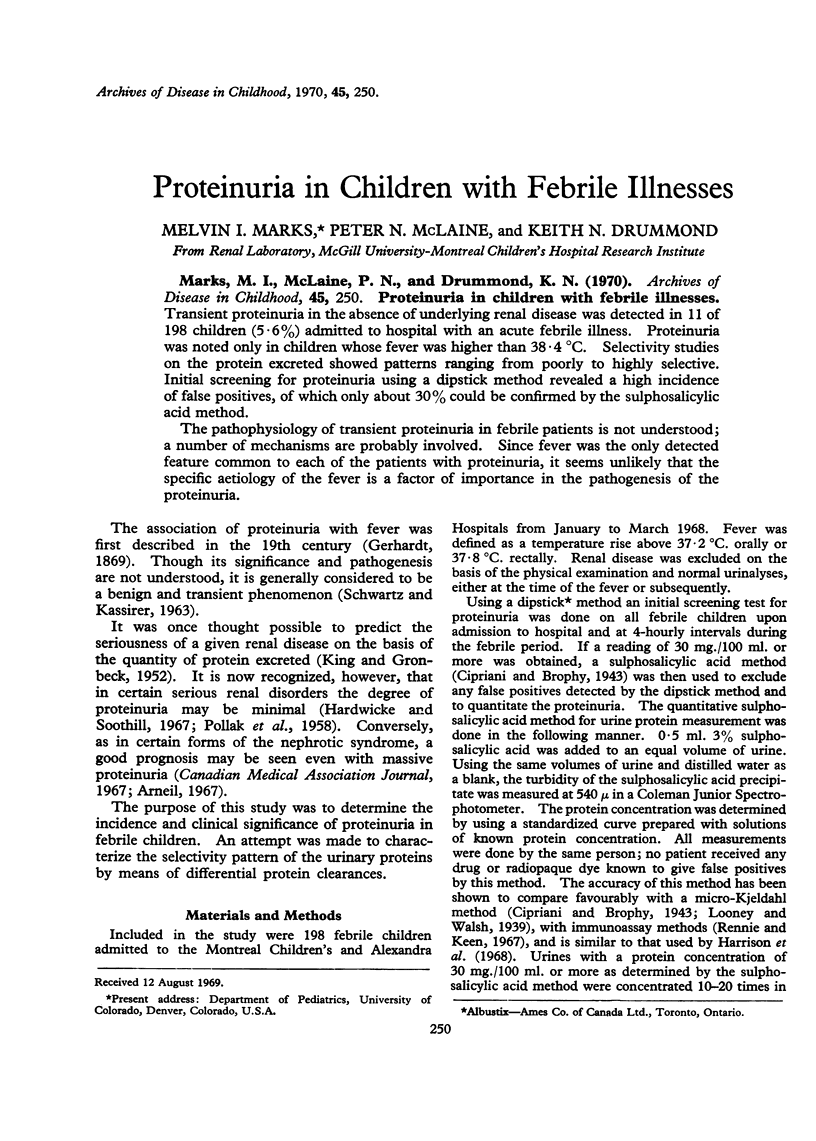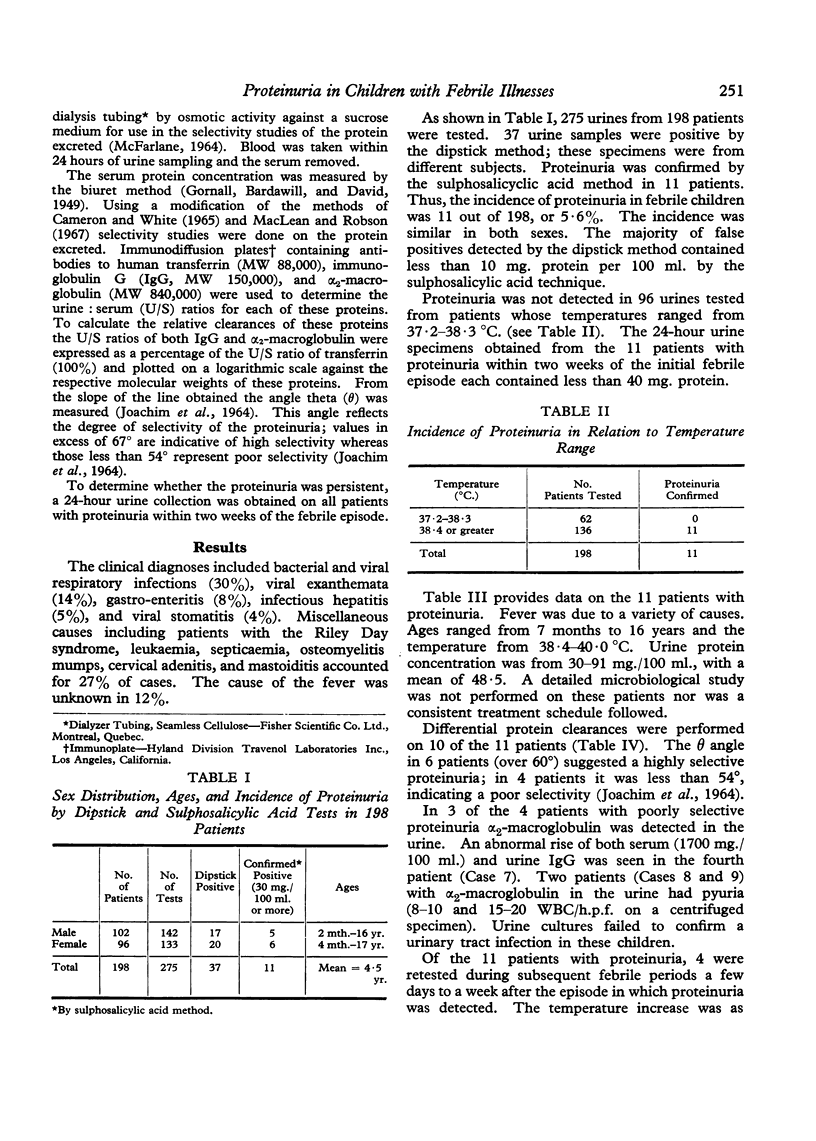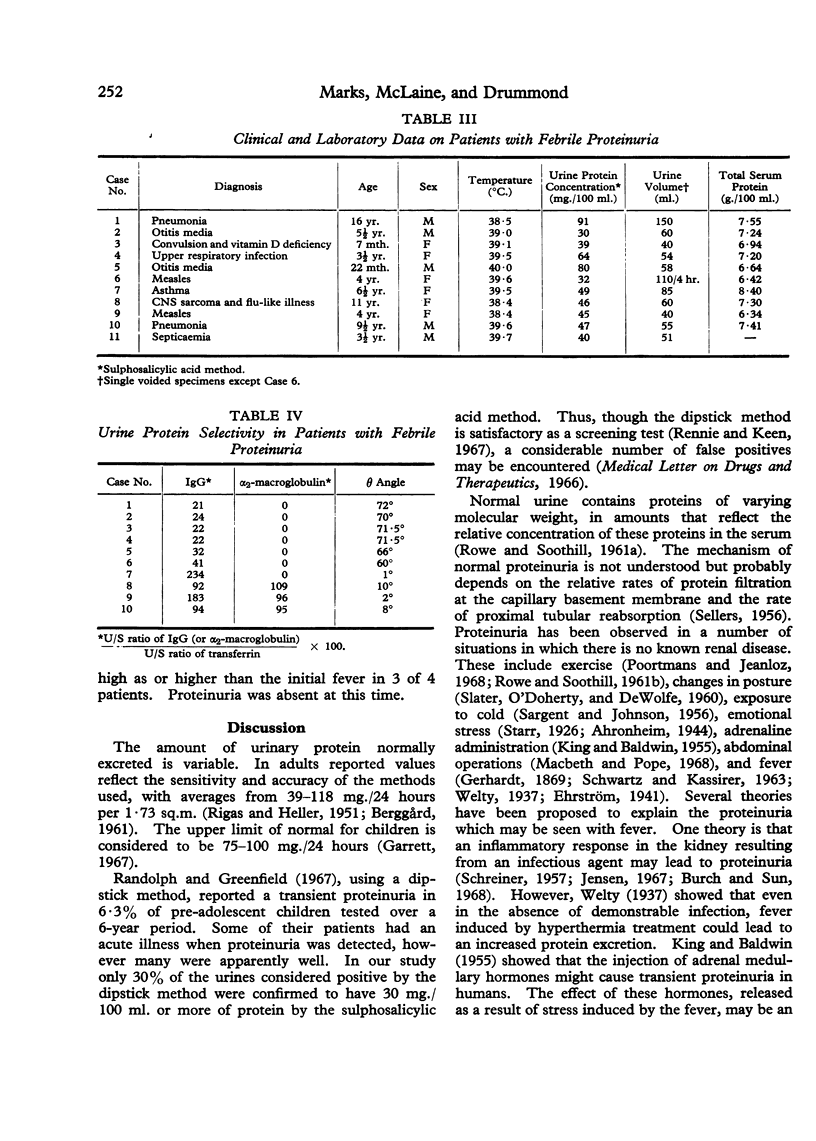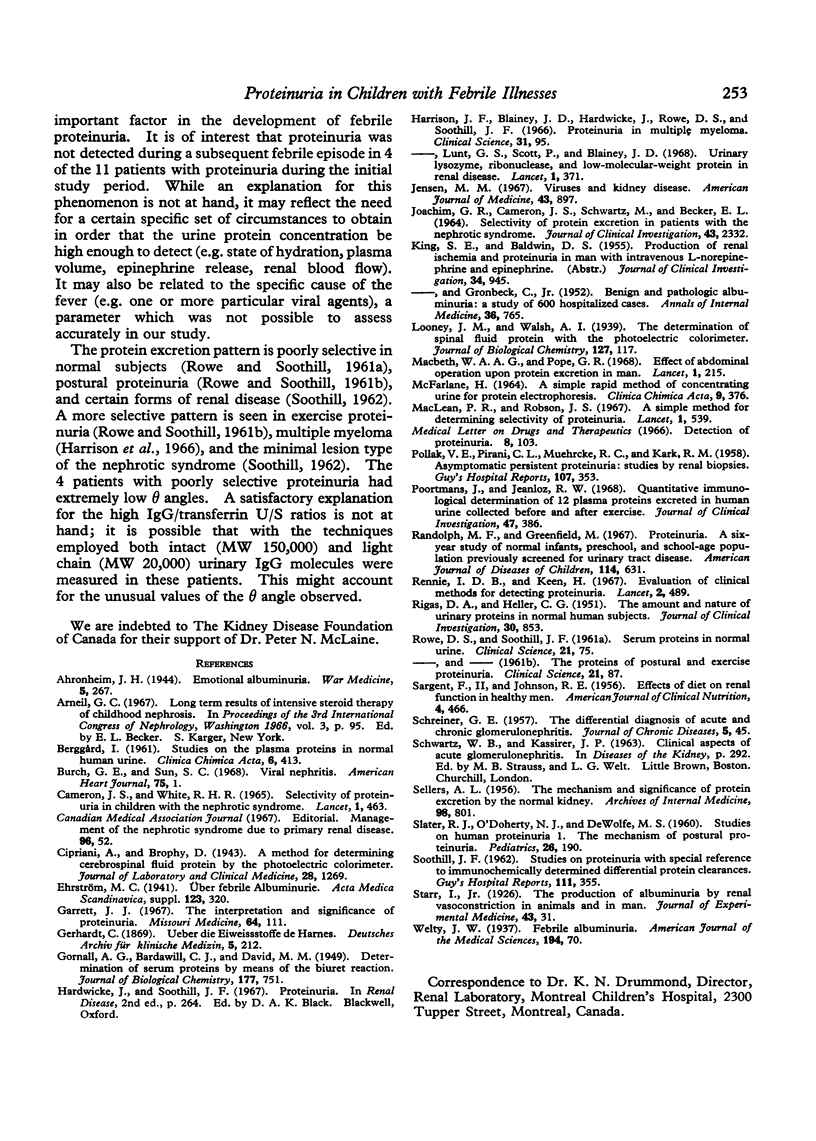Abstract
Transient proteinuria in the absence of underlying renal disease was detected in 11 of 198 children (5·6%) admitted to hospital with an acute febrile illness. Proteinuria was noted only in children whose fever was higher than 38·4 °C. Selectivity studies on the protein excreted showed patterns ranging from poorly to highly selective. Initial screening for proteinuria using a dipstick method revealed a high incidence of false positives, of which only about 30% could be confirmed by the sulphosalicylic acid method.
The pathophysiology of transient proteinuria in febrile patients is not understood; a number of mechanisms are probably involved. Since fever was the only detected feature common to each of the patients with proteinuria, it seems unlikely that the specific aetiology of the fever is a factor of importance in the pathogenesis of the proteinuria.
Full text
PDF



Selected References
These references are in PubMed. This may not be the complete list of references from this article.
- Burch G. E., Sun S. C. Viral nephritis. Am Heart J. 1968 Jan;75(1):1–5. doi: 10.1016/0002-8703(68)90110-5. [DOI] [PubMed] [Google Scholar]
- CAMERON J. S., WHITE R. H. SELECTIVITY OF PROTEINURIA IN CHILDREN WITH THE NEPHROTIC SYNDROME. Lancet. 1965 Feb 27;1(7383):463–465. doi: 10.1016/s0140-6736(65)91593-x. [DOI] [PubMed] [Google Scholar]
- Harrison J. F., Blainey J. D., Hardwicke J., Rowe D. S., Soothill J. F. Proteinuria in multiple myeloma. Clin Sci. 1966 Aug;31(1):95–110. [PubMed] [Google Scholar]
- Harrison J. F., Lunt G. S., Scott P., Blainey J. D. Urinary lysozyme, ribonuclease, and low-molecular-weight protein in renal disease. Lancet. 1968 Feb 24;1(7539):371–375. doi: 10.1016/s0140-6736(68)91350-0. [DOI] [PubMed] [Google Scholar]
- JOACHIM G. R., CAMERON J. S., SCHWARTZ M., BECKER E. L. SELECTIVITY OF PROTEIN EXCRETION IN PATIENTS WITH THE NEPHROTIC SYNDROME. J Clin Invest. 1964 Dec;43:2332–2346. doi: 10.1172/JCI105107. [DOI] [PMC free article] [PubMed] [Google Scholar]
- JOHNSON R. E., SARGENT F., 2nd The effects of diet on renal function in healthy men. Am J Clin Nutr. 1956 Sep-Oct;4(5):466–481. doi: 10.1093/ajcn/4.5.466. [DOI] [PubMed] [Google Scholar]
- Jensen M. M. Viruses and kidney disease. Am J Med. 1967 Dec;43(6):897–911. doi: 10.1016/0002-9343(67)90248-3. [DOI] [PubMed] [Google Scholar]
- KING S. E., GRONBECK C., Jr Benign and pathologic albuminuria; a study of 600 hospitalized cases. Ann Intern Med. 1952 Mar;36(3):765–785. doi: 10.7326/0003-4819-36-3-765. [DOI] [PubMed] [Google Scholar]
- MCFARLANE H. A SIMPLE RAPID METHOD OF CONCENTRATING URINE FOR PROTEIN ELECTROPHORESIS. Clin Chim Acta. 1964 Apr;9:376–380. doi: 10.1016/0009-8981(64)90029-4. [DOI] [PubMed] [Google Scholar]
- MacLean P. R., Robson J. S. A simple method for determining selectivity of proteinuria. Lancet. 1967 Mar 11;1(7489):539–542. doi: 10.1016/s0140-6736(67)92116-2. [DOI] [PubMed] [Google Scholar]
- Macbeth W. A., Pope G. R. Effect of abdominal operation upon protein excretion in man. Lancet. 1968 Feb 3;1(7536):215–217. doi: 10.1016/s0140-6736(68)90845-3. [DOI] [PubMed] [Google Scholar]
- POLLAK V. E., PIRANI C. L., MUEHRCKE R. C., KARK R. M. Asymptomatic persistent proteinuria: studies by renal biopsies. Guys Hosp Rep. 1958;107(4):353–372. [PubMed] [Google Scholar]
- Poortmans J., Jeanloz R. W. Quantitative immunological determination of 12 plasma proteins excreted in human urine collected before and after exercise. J Clin Invest. 1968 Feb;47(2):386–393. doi: 10.1172/JCI105735. [DOI] [PMC free article] [PubMed] [Google Scholar]
- RIGAS D. A., HELLER C. G. The amount and nature of urinary proteins in normal human subjects. J Clin Invest. 1951 Aug;30(8):853–861. doi: 10.1172/JCI102500. [DOI] [PMC free article] [PubMed] [Google Scholar]
- ROWE D. S., SOOTHILL J. F. Serum proteins in normal urine. Clin Sci. 1961 Aug;21:75–85. [PubMed] [Google Scholar]
- Randolph M. F., Greenfield M. Proteinuria. A six-year study of normal infants, preschool, and school-age populations previously screened for urinary tract disease. Am J Dis Child. 1967 Dec;114(6):631–638. doi: 10.1001/archpedi.1967.02090270087008. [DOI] [PubMed] [Google Scholar]
- Rennie I. D., Keen H. Evaluation of clinical methods for detecting proteinuria. Lancet. 1967 Sep 2;2(7514):489–492. doi: 10.1016/s0140-6736(67)91656-x. [DOI] [PubMed] [Google Scholar]
- SCHREINER G. E. The differential diagnosis of acute and chronic glomerulonephritis. J Chronic Dis. 1957 Jan;5(1):45–66. doi: 10.1016/0021-9681(57)90124-8. [DOI] [PubMed] [Google Scholar]
- SELLERS A. L. The mechanism and significance of protein excretion by the normal kidney. AMA Arch Intern Med. 1956 Dec;98(6):801–806. doi: 10.1001/archinte.1956.00250300119013. [DOI] [PubMed] [Google Scholar]
- SLATER R. J., O'DOHERTY N. J., DeWOLFE M. S. Studies on human proteinuria. 1. the mechanism of postural proteinuria. Pediatrics. 1960 Aug;26:190–199. [PubMed] [Google Scholar]
- SOOTHILL J. F. Studies on proteinuria with special reference to immunochemically determined differential protein clearances. Guys Hosp Rep. 1962;111:355–369. [PubMed] [Google Scholar]


